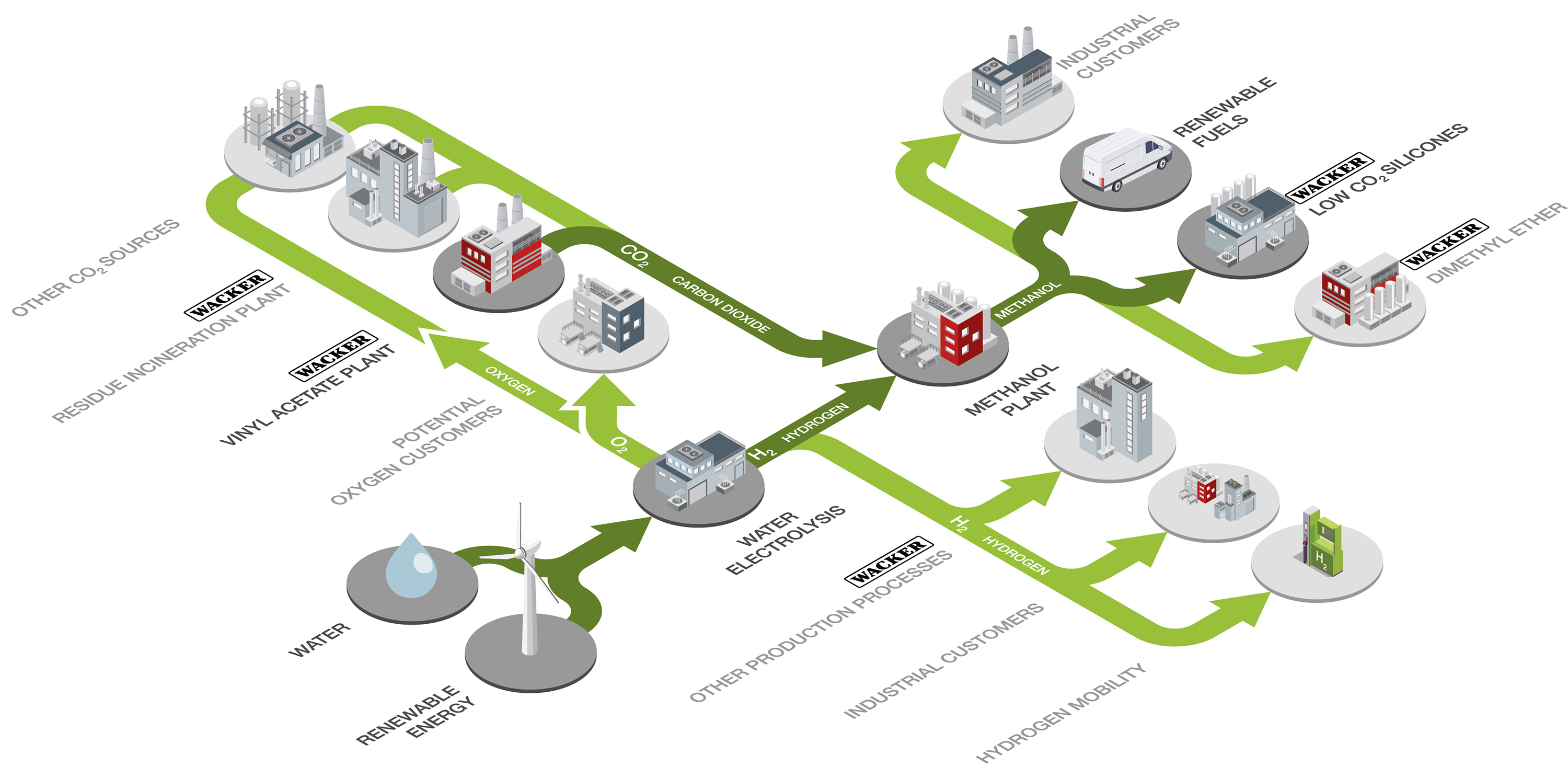WACKER Resubmits RHYME Bavaria for European Union Funding
- PROJECT IS A KEY BUILDING BLOCK IN MEETING THE GOAL OF NET-ZERO PRODUCTION BY 2045
- SOME €100 MILLION TO BE INVESTED, WITH THE AMOUNT OF FUNDING APPLIED FOR IN THE DOUBLE-DIGIT MILLIONS
- CEO CHRISTIAN HARTEL: “BY PRODUCING GREEN HYDROGEN AND USING IT AS A RAW MATERIAL, WE ARE MAKING AN ESSENTIAL CONTRIBUTION TOWARD MARKEDLY REDUCING FOSSIL RESOURCES IN CHEMICAL PROCESSES AND PRODUCTS”
Munich / Burghausen, Mar 07, 2022
Wacker Chemie AG has re-applied for European Union funding for its project for producing green hydrogen and renewable methanol at its Burghausen site. The WACKER Group had applied for funding from the European Commission’s EU Innovation Fund for its RHYME (Renewable Hydrogen and Methanol) Bavaria project in 2020. RHMYE Bavaria prevailed over more than two hundred other projects during the initial evaluation phase. Yet despite being given an excellent rating by the jury, it was unable to qualify during the final stage.

Wacker Chemie AG has re-applied for European Union funding for its project for producing green hydrogen and renewable methanol at its Burghausen site. The WACKER Group had applied for funding from the European Commission’s EU Innovation Fund for its RHYME (Renewable Hydrogen and Methanol) Bavaria project in 2020. RHMYE Bavaria prevailed over more than two hundred other projects during the initial evaluation phase. Yet despite being given an excellent rating by the jury, it was unable to qualify during the final stage.
“The EU has now adjusted its selection criteria as well as increasing annual funding from €1 billion to €1.5 billion, which makes it possible to fund a medium-sized, albeit highly innovative project such as RHYME Bavaria,” explained Christian Hartel, president and CEO of Wacker Chemie AG. “That’s why we think resubmission of this trailblazing project stands a good chance of receiving the necessary EU funding. RHYME Bavaria is a key building block in meeting our ambitious climate-protection and sustainability targets. We want to halve our absolute greenhouse gas emissions by 2030 and achieve net-zero production by 2045.”
RHYME Bavaria refers to a 20-megawatt electrolysis plant that will produce hydrogen from water using renewable electricity. WACKER intends to use carbon dioxide (CO2) from existing production processes to turn this green hydrogen into renewable methanol, a key starting material for making chemical products such as silicones.
The expected capacity of this plant is 15,000 metric tons of methanol per year. Compared with existing manufacturing processes, the new approach to methanol production could avoid CO2 emissions completely. The quantities of carbon dioxide required by RHYME Bavaria would no longer be emitted into the atmosphere. Instead, they would be recycled as a raw material in a chemical production process.
WACKER estimates it will invest some €100 million in the project, with the amount of EU funding applied for in the double-digit millions of euros. The EU’s Innovation Fund has a budget of €10 billion to support innovative low-carbon technologies and processes in energy-intensive industries until 2030.

“Our RHYME Bavaria goal is to narrow our carbon footprint even further,” explained CEO Christian Hartel. “By producing green hydrogen and using it as a material, we are making an essential contribution toward markedly reducing fossil resources in chemical processes and products.”
Such a project was nevertheless still not economical under current conditions, Hartel continued. “That’s why we need state funding to make the move to a renewable hydrogen economy possible.” He added that investment grants weren’t enough. Operating costs needed to be subsidized too, so that a plant such as RHYME Bavaria could be operated profitably in the first few years. What was needed in the medium term, he said, was an electricity price of about 4 cents per kilowatt-hour so that this kind of energy-intensive project did not require funding in order to be profitable.
“As an energy-intensive company, we have been in favor of an industrial electricity price for many years now in order to maintain our international competitiveness even as we accelerate our move toward net-zero status,” he emphasized. “Our processes are among the most efficient in the world – making them some of the most economical too,” he added. “Yet, in Germany, we have to pay an electricity price that is much higher than what our competitors in other parts of the world pay. That hits our entire industry hard.”
Hartel went on to say that precisely the exorbitant rises in German electricity prices over recent months therefore showed how important an internationally competitive industrial electricity price was for export-driven sectors such as the chemical industry. The WACKER CEO also demanded a considerable and rapid expansion of renewable energy sources. Only in this way, he explained, could sufficient amounts of competitively priced green hydrogen be made available for projects such as RHYME Bavaria.
“A project such as RHYME Bavaria might be the initial step in defossilizing chemical processes and products in Bavaria’s so-called chemical triangle,” he added. The chemical triangle is a region in the southeast of Bavaria which is home to numerous chemical companies, including WACKER’s Burghausen site. Today’s integrated hydrogen network in the region could evolve over time into a Bavarian center for green hydrogen. Against this background, Hartel felt that it would be an important political signal if RHYME Bavaria – unlike the outcome of the initial evaluation phase – became the first German project to be subsidized by the EU Innovation Fund.
Presspicture

RHYME

Aerial Burghausen
Burghausen is WACKER’s largest production Asite worldwide. About 8,000 employees work there. (Photo: Wacker Chemie AG)
Order photoContact

Media Contact
Wacker Chemie AG
Media Relations
Christof Bachmair
Tel. +49 89 6279-1830
Send Message
Download
Press Information
(PDF | 365 KB)


